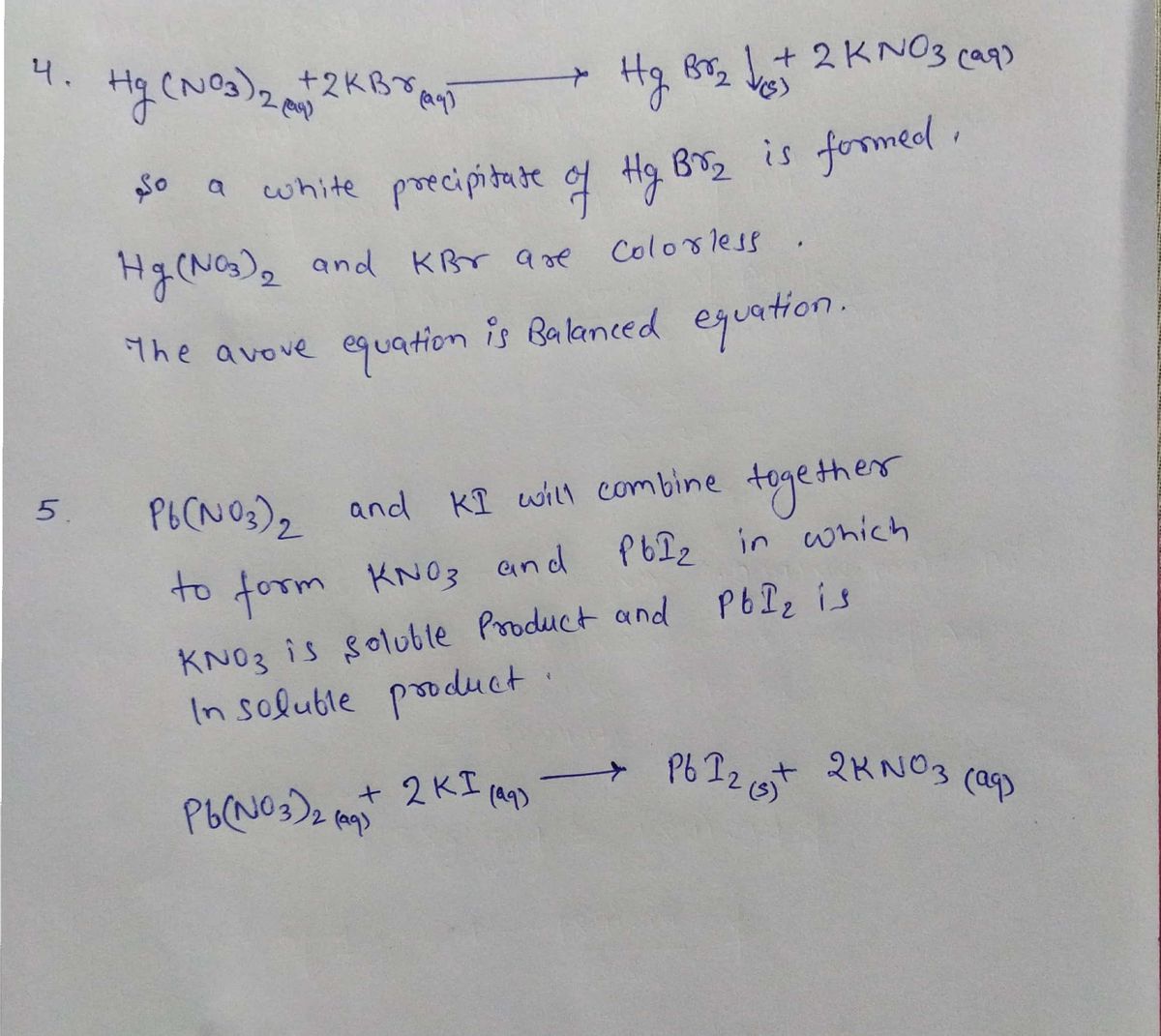2 Why is the observation of an increase in temperature when two substances are mixed not absolute proof that a chemical reaction occurred? 3. When lead (II) nitrate and sodium sulfide are mixed a black solid precipitate is formed. What is the identity of that compound? 4. A solution of Hg(NO3)2 is mixed with a solution of KBr. Both of these solutions are colorless. A white precipitate forms. Write the balanced equation representing the chemical reaction that took place. 5. Pblz is a bright yellow solid that does not dissolve in water. What two solutions can be mixed that would result in a precipitate of Pbl2 being formed?
2 Why is the observation of an increase in temperature when two substances are mixed not absolute proof that a chemical reaction occurred? 3. When lead (II) nitrate and sodium sulfide are mixed a black solid precipitate is formed. What is the identity of that compound? 4. A solution of Hg(NO3)2 is mixed with a solution of KBr. Both of these solutions are colorless. A white precipitate forms. Write the balanced equation representing the chemical reaction that took place. 5. Pblz is a bright yellow solid that does not dissolve in water. What two solutions can be mixed that would result in a precipitate of Pbl2 being formed?
Chemistry
10th Edition
ISBN:9781305957404
Author:Steven S. Zumdahl, Susan A. Zumdahl, Donald J. DeCoste
Publisher:Steven S. Zumdahl, Susan A. Zumdahl, Donald J. DeCoste
Chapter1: Chemical Foundations
Section: Chapter Questions
Problem 1RQ: Define and explain the differences between the following terms. a. law and theory b. theory and...
Related questions
Question
answer 4, 5

Transcribed Image Text:1.
A sample of a solution is tested with red litmus paper. There is no color change. What is the
correct INTERPRETATION of this observation?
- why is the observation of an increase in temperature when two substances are mixed not
absolute proof that a chemical reaction occurred?
3. When lead (II) nitrate and sodium sulfide are mixed a black solid precipitate is formed. What is
the identity of that compound?
4. A solution of Hg(NO3)2 is mixed with a solution of KBr. Both of these solutions are colorless. A
white precipitate forms. Write the balanced equation representing the chemical reaction that
took place.
5. Pblz is a bright yellow solid that does not dissolve in water. What two solutions can be mixed
that would result in a precipitate of Pbl2 being formed?
Expert Solution
Step 1

Trending now
This is a popular solution!
Step by step
Solved in 2 steps with 1 images

Knowledge Booster
Learn more about
Need a deep-dive on the concept behind this application? Look no further. Learn more about this topic, chemistry and related others by exploring similar questions and additional content below.Recommended textbooks for you

Chemistry
Chemistry
ISBN:
9781305957404
Author:
Steven S. Zumdahl, Susan A. Zumdahl, Donald J. DeCoste
Publisher:
Cengage Learning

Chemistry
Chemistry
ISBN:
9781259911156
Author:
Raymond Chang Dr., Jason Overby Professor
Publisher:
McGraw-Hill Education

Principles of Instrumental Analysis
Chemistry
ISBN:
9781305577213
Author:
Douglas A. Skoog, F. James Holler, Stanley R. Crouch
Publisher:
Cengage Learning

Chemistry
Chemistry
ISBN:
9781305957404
Author:
Steven S. Zumdahl, Susan A. Zumdahl, Donald J. DeCoste
Publisher:
Cengage Learning

Chemistry
Chemistry
ISBN:
9781259911156
Author:
Raymond Chang Dr., Jason Overby Professor
Publisher:
McGraw-Hill Education

Principles of Instrumental Analysis
Chemistry
ISBN:
9781305577213
Author:
Douglas A. Skoog, F. James Holler, Stanley R. Crouch
Publisher:
Cengage Learning

Organic Chemistry
Chemistry
ISBN:
9780078021558
Author:
Janice Gorzynski Smith Dr.
Publisher:
McGraw-Hill Education

Chemistry: Principles and Reactions
Chemistry
ISBN:
9781305079373
Author:
William L. Masterton, Cecile N. Hurley
Publisher:
Cengage Learning

Elementary Principles of Chemical Processes, Bind…
Chemistry
ISBN:
9781118431221
Author:
Richard M. Felder, Ronald W. Rousseau, Lisa G. Bullard
Publisher:
WILEY